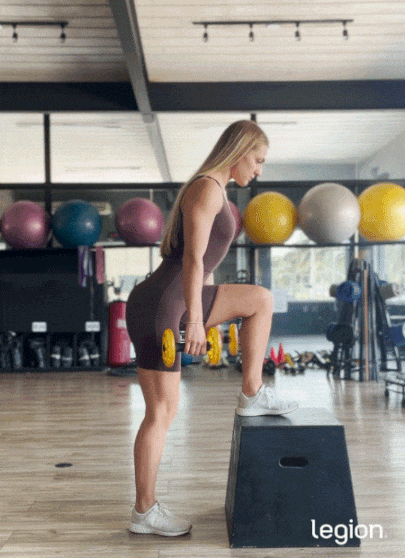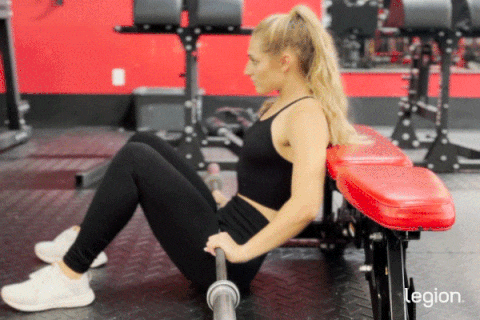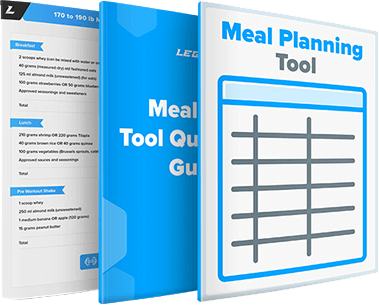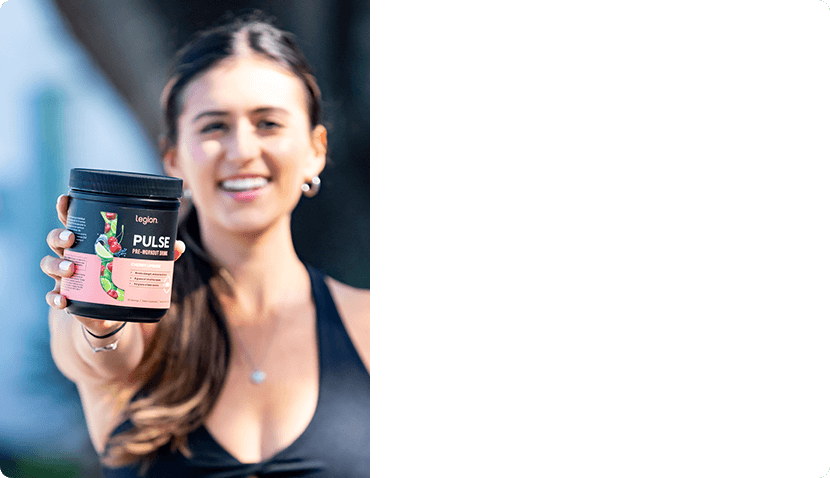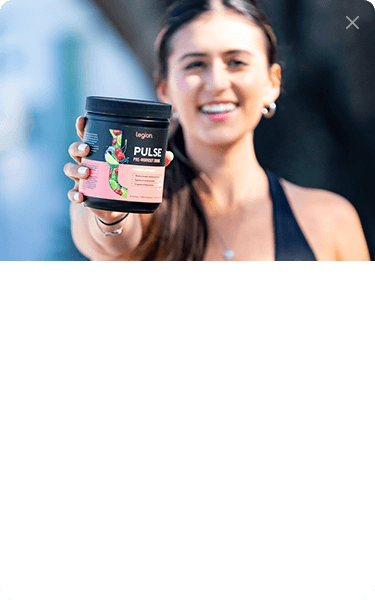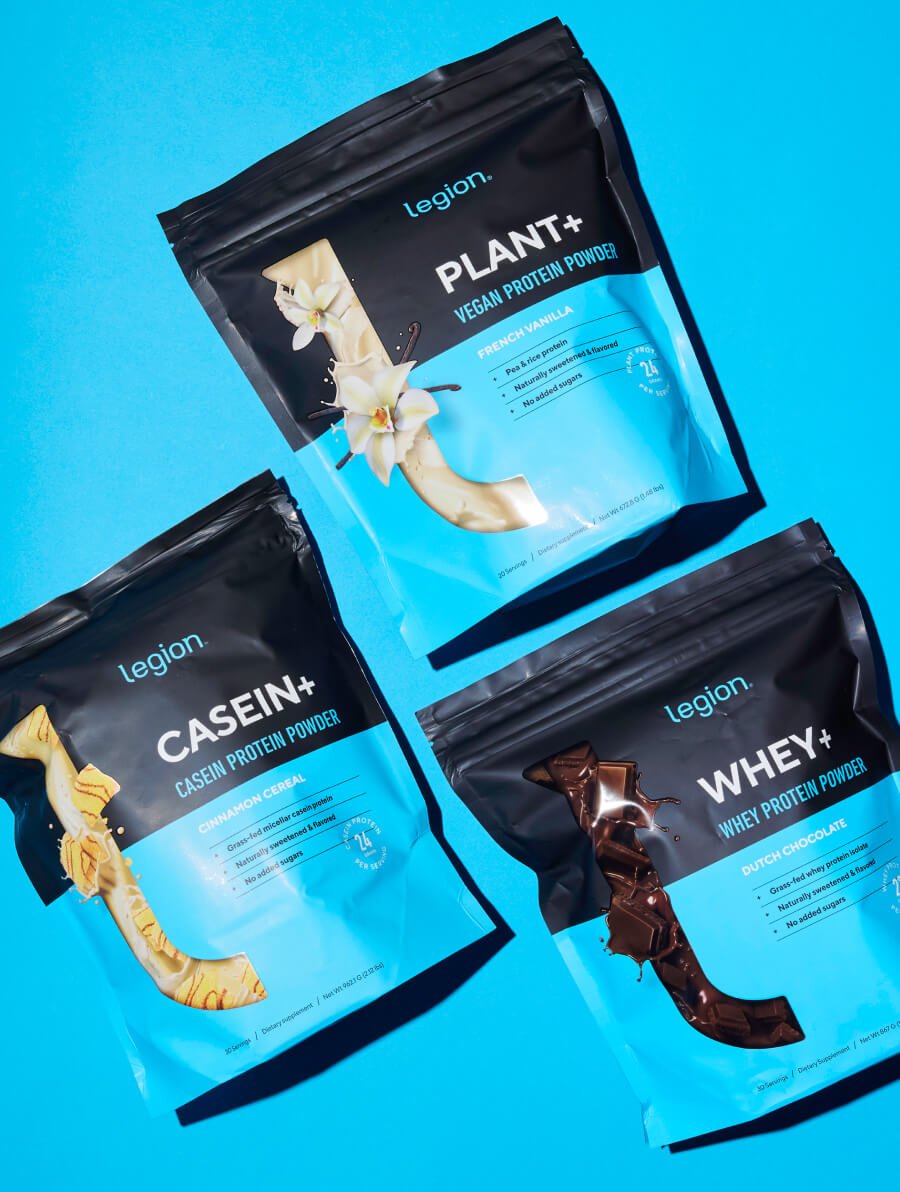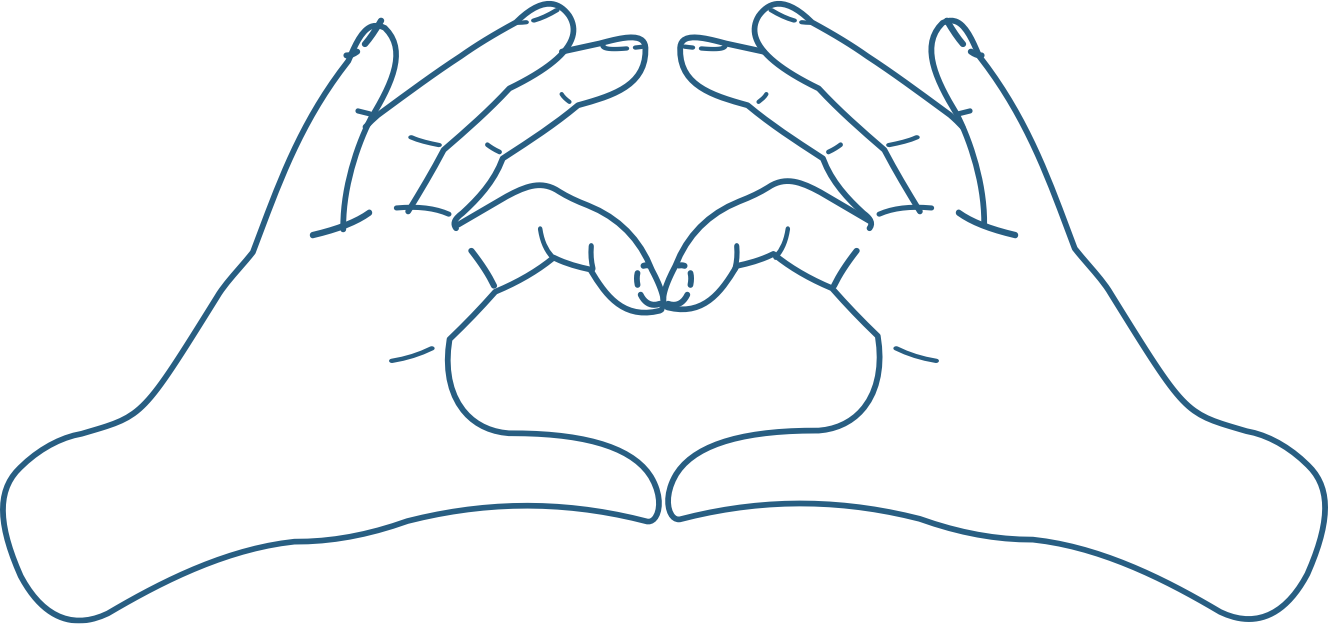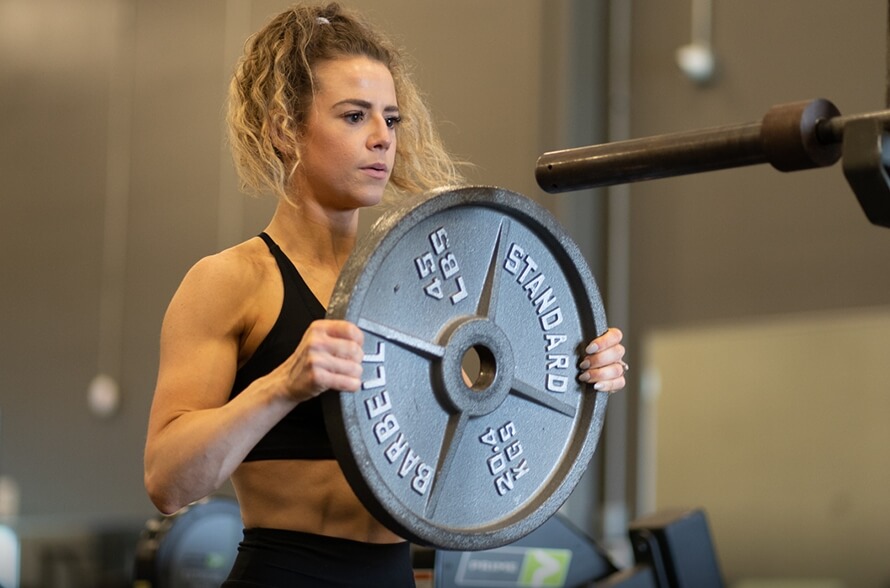
Most lower body training advice for women is still built on outdated myths.
Scroll through social media or search online for a leg day workout for women, and you’ll see the same recycled claims: high reps “tone” your thighs, light weights “shape” your glutes, and dumbbells are somehow better for building more “feminine” legs than barbells.
All of this is wrong.
You don’t tone muscle—you build it. And you don’t build it with workouts designed to avoid sweat or strain. You build it by getting stronger through heavy, compound weightlifting.
That’s what this article will show you. You’ll learn the same principles my coaching team and I have used to help thousands of women build their strongest, most sculpted legs ever.
Key Takeaways
- The fastest way to reshape your lower body is by getting progressively stronger at compound, free-weight exercises like squats, deadlifts, lunges, and hip thrusts.
- Aim to lift heavy—around 75–80% of your one-rep max, or weights you can handle for 8–10 reps per set—take most sets close to failure, and focus on adding weight or reps over time.
- If you’re new to weightlifting, start with one lower-body workout per week; as you get more experienced, split your leg training across 2–3 sessions to better manage fatigue and volume.
- You don’t need supplements to develop an impressive lower body, but protein powder, creatine, and pre-workout can help you get there faster.
Table of Contents
+
How Can a Woman Tone Her Legs Fast?

If you want to tone your legs fast, focus on getting stronger at compound, free-weight exercises like squats, deadlifts, lunges, and hip thrusts.
Most leg day workouts for women, however, miss this point. They tell you things like . . .
- Getting a “pump” in your glutes and legs means you’re gaining muscle.
- Lifting light weights “tones” your lower body.
- Women’s leg workouts should revolve around dumbbell exercises.
All of this may sound more “feminine,” but it’s actually misleading.
Here’s what really works:
Focus on Getting Stronger
Research shows that getting a pump can contribute to muscle growth, but it’s far less important than getting progressively stronger over time.
In other words, if you want to transform your lower body as quickly as possible, you need to consistently add weight or reps to every exercise in each workout. This concept—known as progressive overload—is the single most important driver of muscle growth.
Without it, you’ll eventually stall no matter how many sets, reps, or workouts you do.
Lift Heavy Weights
Here’s something many people don’t realize: You can’t “lengthen,” “tighten,” or “tone” a muscle—you can only build it. And as we’ve already seen, the best way to build muscle is to get stronger over time.
So, what’s the best way to get stronger?
Ditch the endless high-rep “toning” workouts and start lifting heavy weights.
By “heavy,” that means using weights around 75–80% of your one-rep max, or the amount you can lift for 8–10 reps per set.
Do Barbell, Dumbbell, and Machine Exercises
There’s a common belief that barbells are great for men, but women do better with dumbbells.
That simply isn’t true. Barbells, dumbbells, and machines are all just tools that make strength training more practical. They all help you build muscle and strength—they just do it in slightly different ways, each with their own pros and cons.
Here’s a quick look at how they compare:
Barbells vs. Dumbbells vs. Machines for Women’s leg Exercises
| Pros of Barbell Exercises | Pros of Dumbbell Exercises | Pros of Machine Exercises |
|---|---|---|
| More balanced and stable than dumbbells, making it easier to control heavy weights | Less intimidating than barbells and great for beginners | Require little balance or coordination, so ideal for beginners |
| Fewer moving parts than dumbbell exercises, so often easier to learn proper form | Allow you to start with lighter weights since you’re not limited by the barbell’s 45-pound minimum | Easy to learn and perform safely, even without a spotter |
| Allow smaller, more manageable weight increases, so applying progressive overload is more sustainable | Enable a greater range of motion and more natural movement | Useful for doing additional work when you’re too fatigued to safely perform more free-weight exercises |

In other words, they complement each other, and all three deserve a place in a well-designed leg workout routine for women.
And if you want proof this approach works, just look at the results of women who followed Legion’s body transformation coaching program. In just a few months, they toned their legs and glutes using the exact same principles you’ll learn in this article.
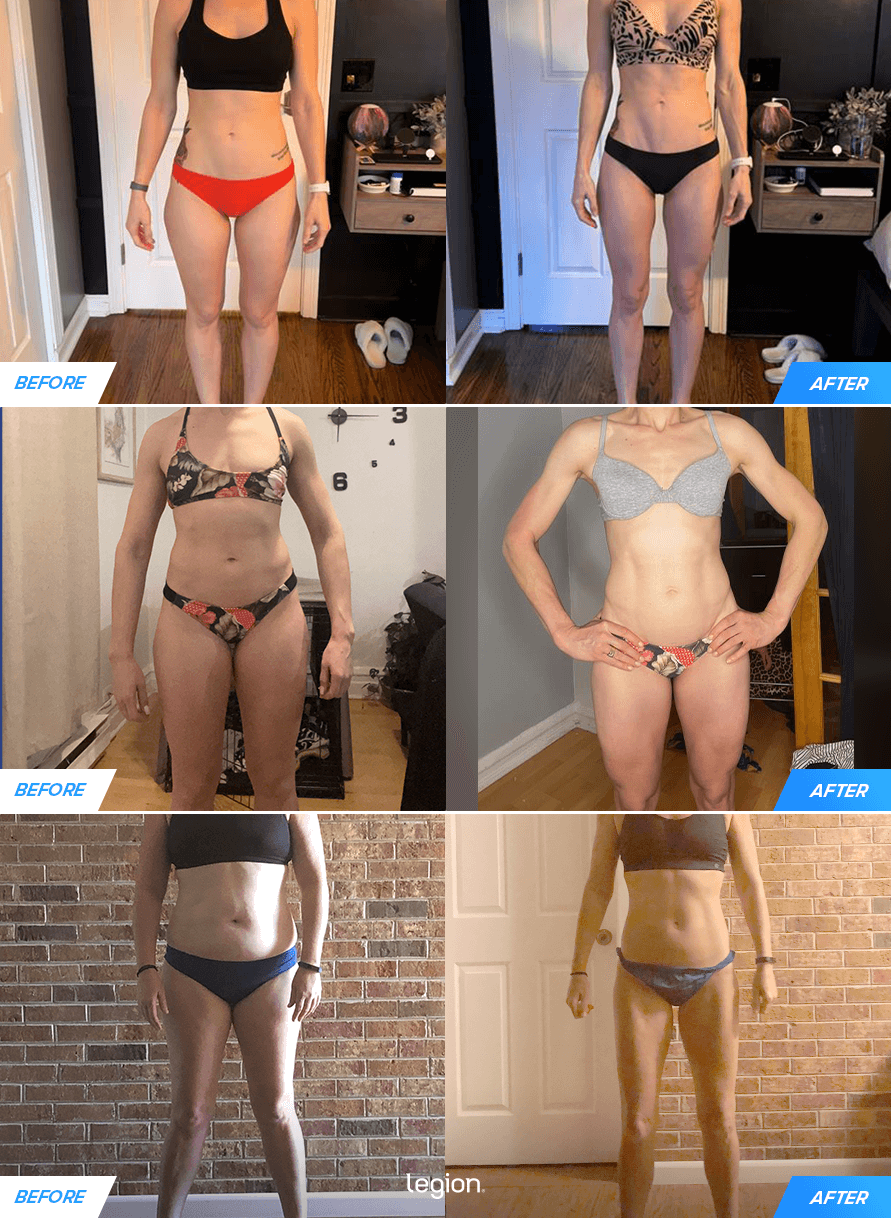
15 Best Leg Day Exercises for Women
The best lower-body workouts for women focus on exercises that let you lift heavy weights safely, target all the major muscles of your legs and glutes, and progressively build strength and shape over time.
Here are 15 of the most effective movements to include in your routine.
1. Back Squat
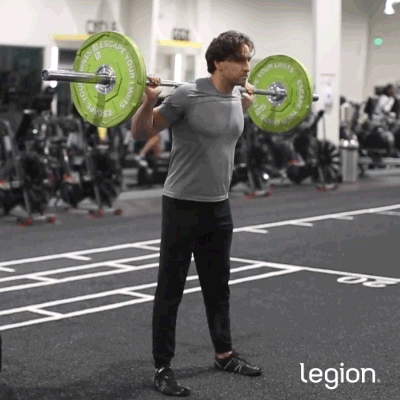
Main Muscles Worked: Quads and glutes
How to:
- Set a barbell in a rack at about chest height.
- Step under it, pinch your shoulder blades together, and rest the bar across your upper back.
- Lift the bar out, step back, and set your feet slightly wider than shoulder-width with your toes turned out.
- Keeping your back straight, sit down and push your knees out in the same direction as your toes.
- Reverse the movement and return to the starting position.
Sets, Reps, and Rest: 3 sets | 8–10 reps | 3–5 minutes rest
READ MORE: How to Do the Back Squat: Form, Benefits, and More
2. Romanian Deadlift
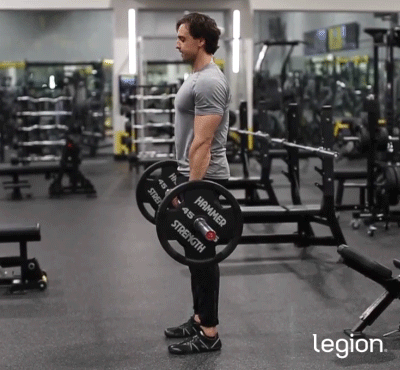
Main Muscles Worked: Hamstrings and glutes
How to:
- Stand with your feet hip-width apart and hold the barbell with a shoulder-width, overhand grip.
- Keep your back flat and push your hips back to lower the bar straight toward the floor.
- Lower until you feel a deep stretch in your hamstrings or just before your lower back rounds.
- Reverse the movement and return to the starting position.
Sets, Reps, and Rest: 3 sets | 8–10 reps | 3–5 minutes rest
READ MORE: How to Do the Romanian Deadlift: Form, Benefits, and Variations
3. Front Squat
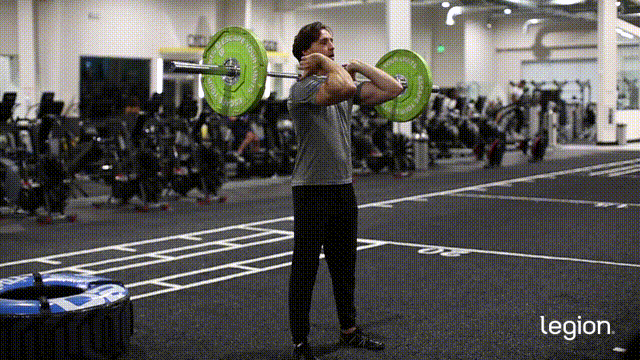
Main Muscles Worked: Quads and glutes
How to:
- Set a barbell in a rack at about breastbone height.
- Grip the bar at shoulder width with your palms facing forward and step in until it touches your upper chest.
- Raise your elbows so they point forward, resting the bar across the front of your shoulders.
- Lift it out of the rack, step back, and set your feet slightly wider than shoulder-width with your toes turned out.
- Keeping your back straight, sit down and push your knees out in the same direction as your toes.
- Reverse the movement and return to the starting position.
Sets, Reps, and Rest: 3 sets | 8–10 reps | 3–5 minutes rest
READ MORE: How to Front Squat: Form, Benefits & Alternatives
4. Single-Leg Romanian Deadlift
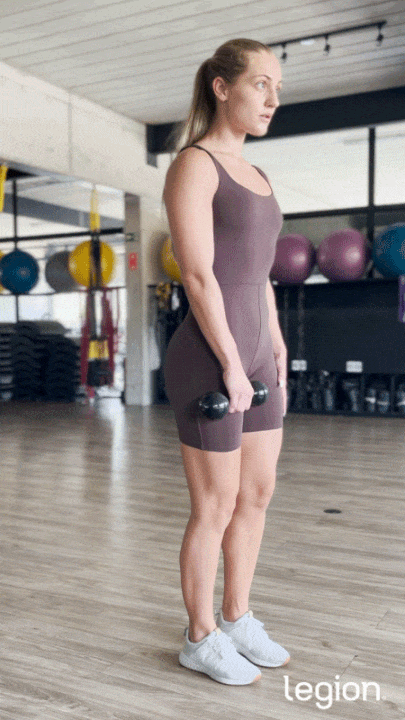
Main Muscles Worked: Hamstrings and glutes
How to:
- Stand upright holding a dumbbell in your right hand in front of your thigh.
- Keep your back flat and push your hips back as you lower the weight straight toward the floor, letting your left leg extend behind you for balance.
- Lower until you feel a deep stretch in your right hamstring or just before your lower back rounds.
- Reverse the movement and return to the starting position.
- Complete all reps on one leg, then switch sides.
Sets, Reps, and Rest: 3 sets | 8–10 reps | 3–5 minutes rest
5. Bulgarian Split Squat
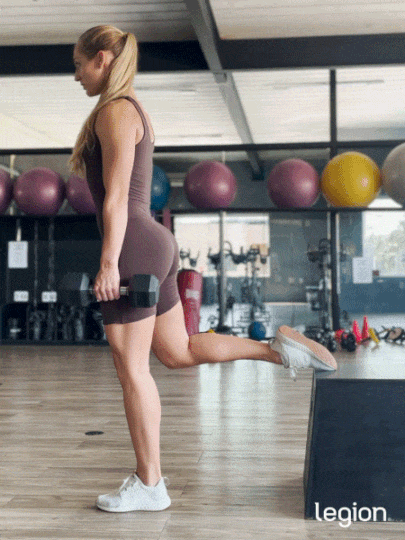
Main Muscles Worked: Quads and glutes
How to:
- Hold a dumbbell in each hand and stand 2–3 feet in front of a bench.
- Place the top of your left foot on the bench behind you and keep your right heel planted.
- Lower your hips by bending your right knee until it’s at about 90 degrees.
- Reverse the movement and return to the starting position.
- Complete all reps on one side, then switch legs.
Sets, Reps, and Rest: 3 sets | 8–10 reps | 2–3 minutes rest
READ MORE: How to Perform Bulgarian Split Squats for Glutes, Hamstrings & Quad Growth
6. Reverse Lunge
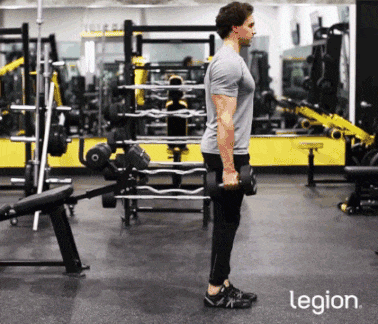
Main Muscles Worked: Quads and glutes
How to:
- Holding a dumbbell in each hand, stand up straight with both feet about hip-width apart.
- Step back 2–3 feet with your left leg, keeping most of your weight on your right foot.
- Lower your body by bending both knees until your left knee touches the floor.
- Reverse the movement and return to the starting position.
- Repeat the movement on your left side.
Sets, Reps, and Rest: 3 sets | 8–10 reps | 2–3 minutes rest
READ MORE: Dumbbell Reverse Lunge: Muscles Worked, Form & Variations
7. Step-up
Main Muscles Worked: Glutes and quads
How to:
- Holding a dumbbell in each hand, place your right foot on a stable surface about knee-height off the floor.
- Keeping your weight on your right foot, fully straighten your right leg.
- Reverse the movement and return to the starting position.
- Complete all reps on one side, then switch legs.
Sets, Reps, and Rest: 3 sets | 8–10 reps | 2–3 minutes rest
READ MORE: Weighted Step-Ups Guide: How to Do Dumbbell Step-Ups
8. Curtsy Lunge
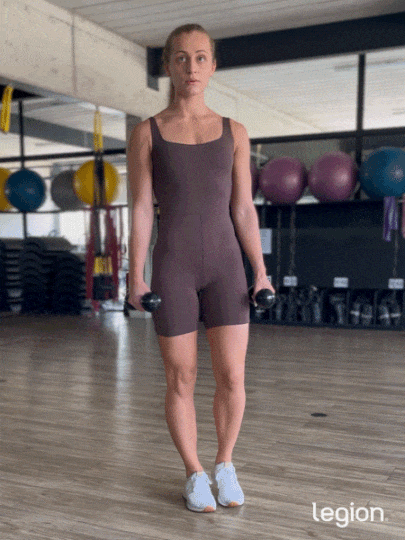
Main Muscles Worked: Glutes and quads
How to:
- Hold a dumbbell in each hand and stand with your feet hip-width apart.
- Step diagonally backward with your left leg so it crosses behind your right.
- Keeping most of your weight on your right leg, bend both knees until your left knee nearly touches the floor.
- Reverse the movement and return to the starting position.
- Complete all reps on one side, then switch legs.
Sets, Reps, and Rest: 3 sets | 8–10 reps | 2–3 minutes rest
9. Hip Thrust
Main Muscles Worked: Glutes and hamstrings
How to:
- Sit on the floor with your upper back against a bench set perpendicular to your body.
- Roll a barbell over your legs so it rests in your hip crease.
- Plant your feet shoulder-width apart and about 12–18 inches from your glutes.
- Drive through your heels to lift your hips until your torso is parallel to the floor and your shins are vertical.
- Reverse the movement and return to the starting position
Sets, Reps, and Rest: 3 sets | 8–10 reps | 2–3 minutes rest
READ MORE: How to Do the Barbell Hip Thrust: Form, Mistakes & Alternatives.
10. Goblet Squat
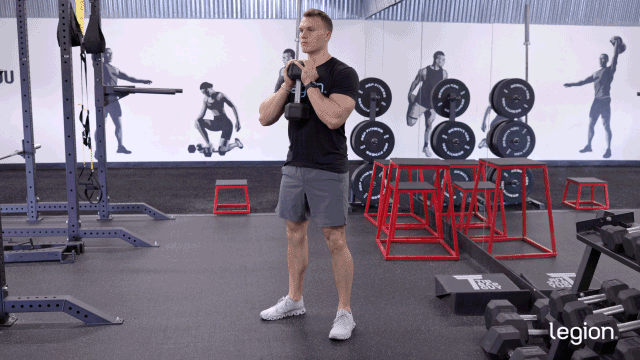
Main Muscles Worked: Quads and glutes
How to:
- Hold a dumbbell in front of your chest with both hands.
- Place your feet a little wider than shoulder-width apart, point your toes slightly outward, and raise your chest.
- Keeping your back straight, sit down and push your knees out in the same direction as your toes.
- Stand up and return to the starting position.
Sets, Reps, and Rest: 3 sets | 8–10 reps | 2–3 minutes rest
READ MORE: Goblet Squat: Form, Muscles Worked, & Common Mistakes
11. Leg Press
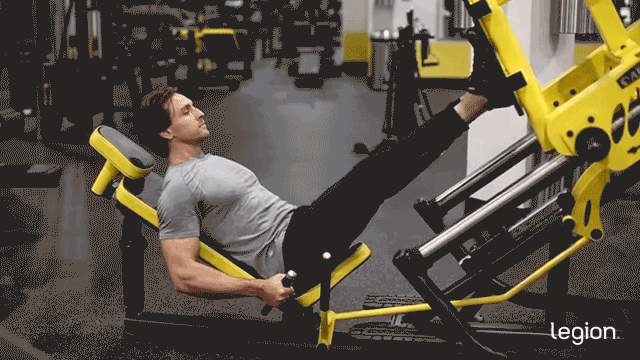
Main Muscles Worked: Quads and glutes
How to:
- Sit down and push your hips back firmly into the seat.
- Place your feet halfway up the footplate, slightly wider than shoulder-width, with your toes turned slightly outward.
- Straighten your legs and use the safety handles to release the weight.
- Lower the footplate toward you until your thighs are about 12–18 inches from your chest.
- Press the footplate back up until your legs are almost—but not fully—straight (keep a slight bend in your knees).
Sets, Reps, and Rest: 3 sets | 8–10 reps | 2–3 minutes rest
READ MORE: How to Do the Leg Press: Benefits, Form, & Alternatives
12. Hack Squat
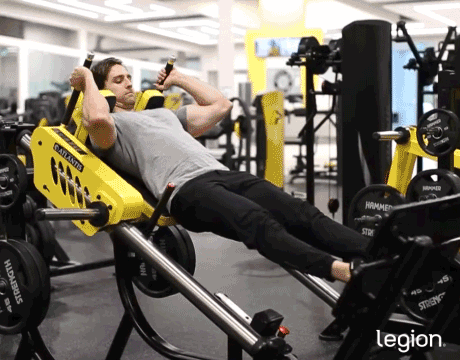
Main Muscles Worked: Quads and glutes
How to:
- Stand on the hack squat footplate with your feet shoulder-width apart and toes turned slightly outward.
- Straighten your knees and use the safety handles to release the weight.
- Keeping your back against the pad, sit down and push your knees out in the same direction as your toes.
- Stand up and return to the starting position.
Sets, Reps, and Rest: 3 sets | 8–10 reps | 2–3 minutes rest
READ MORE: How to Hack Squat for Leg Mass & Strength
13. Single-Leg Hip Thrust

Main Muscles Worked: Glutes and hamstrings
How to:
- Sit on the floor with your shoulders against a bench set perpendicular to your body.
- Place a dumbbell in your hip crease and plant your feet shoulder-width apart, about 12–18 inches from your glutes.
- Lift your left leg off the floor and press through your right heel to raise your hips until your torso and right thigh are parallel to the floor and your right shin is vertical.
- Reverse the movement and return to the starting position.
- Complete all reps on one side, then switch legs.
Sets, Reps, and Rest: 3 sets | 8–10 reps | 2–3 minutes rest
14. Glute Bridge
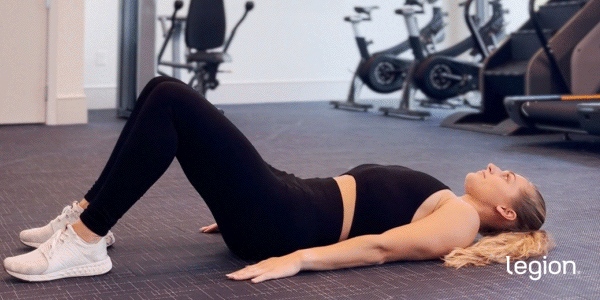
Main Muscles Worked: Glutes and hamstrings
How to:
- Lie on your back with your arms at your sides and palms flat on the floor.
- Place your feet 15–18 inches apart and 6–12 inches from your glutes, with your toes slightly turned out.
- Press through your heels to lift your hips, driving your knees out and squeezing your glutes until your body forms a straight line from knees to shoulders.
- Reverse the movement and return to the starting position.
Sets, Reps, and Rest: 3 sets | 8–10 reps | 2–3 minutes rest
READ MORE: How to Do the Glute Bridge: Form, Benefits, and Variations
15. B-Stance Romanian Deadlift
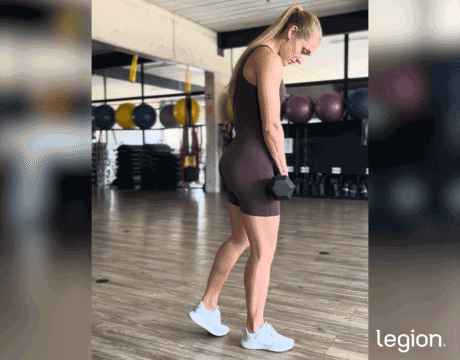
Main Muscles Worked: Glutes and hamstrings
How to:
- Stand with your feet hip-width apart and hold a dumbbell in your right hand.
- Move your left foot a few inches back so your toes line up with your right heel, keeping your left heel raised.
- Keep your back flat and push your hips back to lower the dumbbell straight toward the floor, keeping most of your weight on your front leg.
- Lower until you feel a stretch in your front hamstring or just before your lower back rounds.
- Reverse the movement and return to the starting position.
- Complete all reps on one side, then switch legs.
Sets, Reps, and Rest: 3 sets | 8–10 reps | 2–3 minutes rest
Best Leg Day Workout Routine for Women
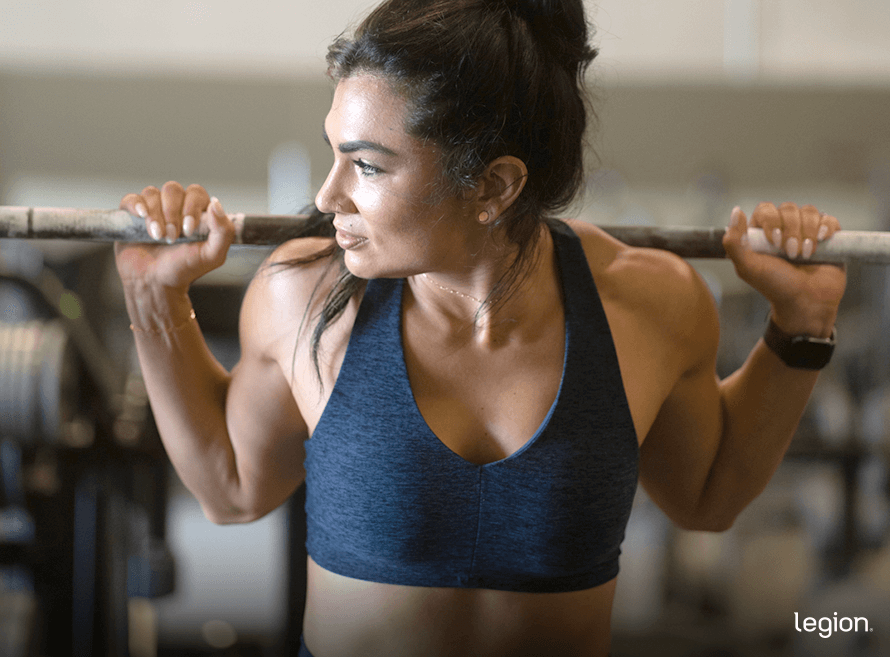
Most online guides to leg and butt workouts for women list a bunch of exercises and tell you to pick a few for your next leg day.
The problem is, when you combine movements at random, you often overwork some muscles and neglect others, creating muscle and strength imbalances that make your legs look uneven and can increase your risk of injury.
To fix that, follow this balanced leg workout at the gym for females. It trains all the major muscles of your lower body and helps you build symmetrical strength and shape:
- Back Squat: 3 sets | 8–10 reps | 3–5 min rest
- Romanian Deadlift: 3 sets | 8–10 reps | 3–5 min rest
- Reverse Lunge: 3 sets | 8–10 reps | 2–3 min rest
- Hip Thrust: 3 sets | 8–10 reps | 2–3 min rest
How Many Days a Week Should Women Train Their Legs?
If you’re new to strength training, you can make excellent progress training your legs once per week with a leg day like the one in this article. This lets you do 10–12 hard sets for your lower body, which is sufficient to stimulate muscle growth as a newbie.
As you become more experienced, though, your body becomes less responsive to weight training.
At that point, you’ll need to do more sets per week—usually around 15–20—to continue building muscle. The best way to do this is to increase how often you train your legs to spread that work across two or more workouts per week.
For example, you might do one dedicated leg day and another workout later in the week that includes squats, deadlifts, or lunges.
This approach prevents any single workout from becoming too long or fatiguing and helps you maintain better performance and recovery.
Do You Need Supplements to Support Your Leg Day Gains?
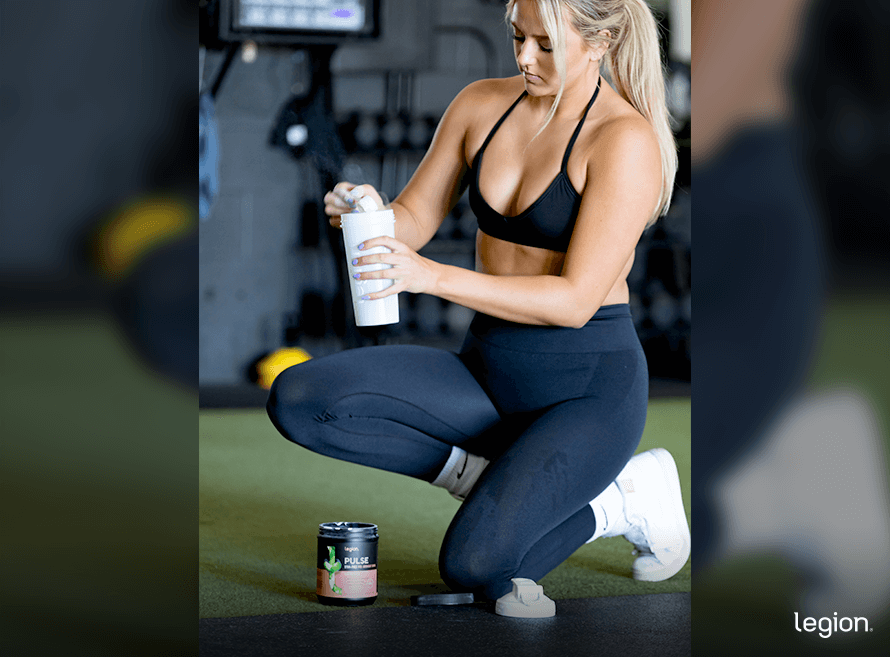
You don’t need supplements to build a strong, sculpted lower body, but the right ones can help. Here are three worth considering:
- Protein powder: Eating enough protein is essential for building lower body muscle. Protein powders like Whey+, Casein+, and Egg+ make hitting your target easier.
- Creatine: Creatine boosts muscle and strength gain, improves endurance, and reduces muscle damage and soreness. For a natural source of creatine, try Legion’s creatine monohydrate powder, creatine gummies, creatine capsules, or post-workout Recharge.
- Pre-workout: A quality pre-workout helps you train harder by boosting energy, focus, and athletic performance. Legion’s Pulse is available with or without caffeine.
Want even more specific supplement advice? Take the Legion Supplement Finder Quiz to learn exactly what supplements are right for you.
How Hard Should Your Leg Day Training Be?
Take most of your sets 1–2 reps shy of failure—the point where you couldn’t perform another rep with proper form even if you tried.
To gauge whether you’re reaching this point, ask yourself at the end of each set: “If I had to, how many more reps could I have done with good form?” If the answer is more than two, increase the weight or reps on your next set to make it more challenging.
Training this way ensures you’re pushing your quads, glutes, and hamstrings hard enough to stimulate growth without burning out.
How Do You Progress in Your Leg Day Training?
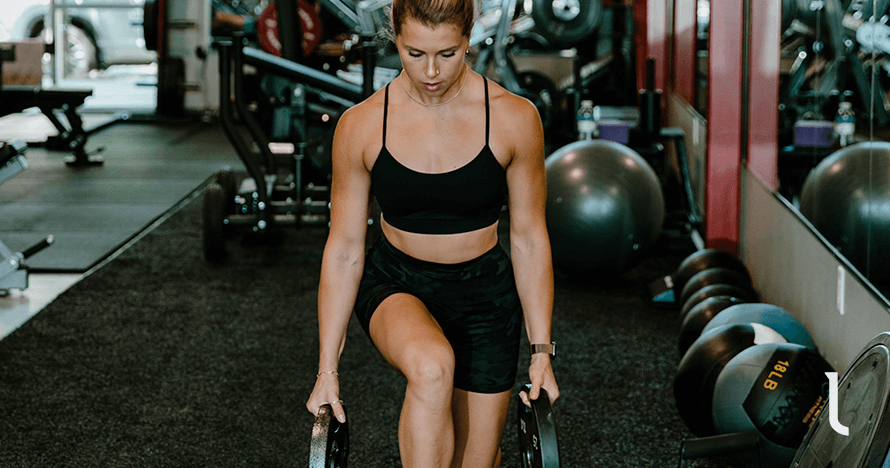
As you already know, progression is what drives muscle growth—and it’s the real “secret” to transforming your lower body. The goal is simple: make your workouts a little harder over time.
Here’s how to do it:
- If your workout calls for 8–10 reps of the squat and you complete 10 reps in a set, increase the weight by 10 pounds for your next set.
- If you do 7 reps or fewer in subsequent sets, reduce the load by 5 pounds to stay in the 8–10 rep range.
Apply this approach to every exercise in your leg day workouts, aiming to add either weight or reps every session. And if you want to learn more about this method, check out this article:
The Double Progression Method for Getting Bigger and Stronger | Legion
The Bottom Line on Leg Day Workouts for Women
Firm, shapely legs don’t come from endless high-rep “toning” workouts. They come from getting progressively stronger at compound, free-weight exercises, eating enough protein and calories, and getting adequate rest.
That’s the formula we’ve used to help thousands of women in our coaching programs build strong, sculpted lower bodies, and it’ll work for you, too.
FAQ #1: What are the benefits of leg day workouts for women?
Leg training does far more than “tone” your thighs and glutes. It helps you build strength and power, and increase athleticism, and may even improve balance.
Stronger legs make everyday activities easier, too—from climbing stairs to getting out of a chair—and help prevent injuries by building the muscles that stabilize your hips and knees, improving your coordination, and helping your body better absorb impact.
FAQ #2: How long does it take to tone your legs?
If you train consistently, eat enough protein, and consume the right number of calories to support your goals, you can expect to see noticeable changes in your legs within 3–6 months.
FAQ #3: Will lifting heavy make my legs bulky?
No. It’s very hard for women to build big, bulky legs. It doesn’t happen by accident or overnight. And if it does happen, it takes elite muscle-building genetics and years of concerted effort in the gym and kitchen.
For most women, lifting heavy simply makes their legs and butt look firmer and more shapely and defined. The “toned” look many women want is just muscle with less fat covering it, which comes from combining strength training with a calorie-appropriate diet.
Want More Content Like This?
Check out these articles:
- The Ultimate 3-Month Female Body Recomposition Workout Plan
- The 3 Best Workout Splits for Women
- Transform Your Pear-Shaped Body: Exercises & Diet Tips
Scientific References +
- Schoenfeld, Brad J., et al. “Strength and Hypertrophy Adaptations between Low- vs. High-Load Resistance Training.” Journal of Strength and Conditioning Research, vol. 31, no. 12, Dec. 2017, pp. 3508–3523, https://doi.org/10.1519/jsc.0000000000002200.
- Schoenfeld, Brad J. “The Mechanisms of Muscle Hypertrophy and Their Application to Resistance Training.” Journal of Strength and Conditioning Research, vol. 24, no. 10, Oct. 2010, pp. 2857–72, https://doi.org/10.1519/JSC.0b013e3181e840f3.
- McHugh, Malachy P. “Recent Advances in the Understanding of the Repeated Bout Effect: The Protective Effect against Muscle Damage from a Single Bout of Eccentric Exercise.” Scandinavian Journal of Medicine and Science in Sports, vol. 13, no. 2, Apr. 2003, pp. 88–97, https://doi.org/10.1034/j.1600-0838.2003.02477.x.
- Eckerson, Joan M., et al. “Effect of Creatine Phosphate Supplementation on Anaerobic Working Capacity and Body Weight after Two and Six Days of Loading in Men and Women.” The Journal of Strength and Conditioning Research, vol. 19, no. 4, 2005, p. 756, https://doi.org/10.1519/r-16924.1.
- Bassit, Reinaldo Abunasser, et al. “Effect of Short-Term Creatine Supplementation on Markers of Skeletal Muscle Damage after Strenuous Contractile Activity.” European Journal of Applied Physiology, vol. 108, no. 5, 3 Dec. 2009, pp. 945–955, https://doi.org/10.1007/s00421-009-1305-1.
- Nigro, Federico, and Sandro Bartolomei. “A Comparison between the Squat and the Deadlift for Lower Body Strength and Power Training.” Journal of Human Kinetics, vol. 73, no. 1, 21 July 2020, pp. 145–152, https://doi.org/10.2478/hukin-2019-0139.
- Seitz, Laurent B., et al. “Increases in Lower-Body Strength Transfer Positively to Sprint Performance: A Systematic Review with Meta-Analysis.” Sports Medicine, vol. 44, no. 12, 25 July 2014, pp. 1693–1702.
- Muehlbauer, Thomas, et al. “Associations between Measures of Balance and Lower-Extremity Muscle Strength/Power in Healthy Individuals across the Lifespan: A Systematic Review and Meta-Analysis.” Sports Medicine, vol. 45, no. 12, 28 Sept. 2015, pp. 1671–1692, https://doi.org/10.1007/s40279-015-0390-z. Accessed 7 Sept. 2019.
- Chen, Zhengxiang, et al. “Adherence to Strength Training and Lower Rates of Sports Injury in Contact Sports: A Systematic Review and Meta-Analysis.” Orthopaedic Journal of Sports Medicine, vol. 13, no. 5, May 2025, https://doi.org/10.1177/23259671251331134. Accessed 1 June 2025.
- Durán-Custodio, Roberto, et al. “High-Load Strength Training Reduces Injury Incidence and Injury Burden and Improves Physical Fitness in Young Highly Trained Soccer Players.” Sports Health a Multidisciplinary Approach, 27 Apr. 2025, pmc.ncbi.nlm.nih.gov/articles/PMC12037537/#section22-19417381251333417, https://doi.org/10.1177/19417381251333417. Accessed 4 June 2025.
